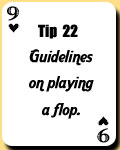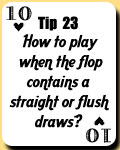Guidelines on playing a flop.
This advice would apply to any circumstance in which the flop would consist of two face cards and one  small card, without a flush draw.
small card, without a flush draw.
Contrasting the previous example, this flop would probably have hit your poker rival in some way, either by pairing him or by giving him a straight draw. Consequently, you wouldn’t need to feel the same compulsion to bet when it would be checked to you as in the ace, nine, and three scenario. It would still be okay to bet with a very marginal poker hand (An ace and a ten, for instance), but you would have to have some outs to fall back on.
Against one poker rival, it would be appropriate to bet with a pair of queens or better, as well as a ten and jack (open-end straight draw). If he were the first to act and bet, you should call with a queen and ten or better. Also, you should raise with a king and jack or better. This would not be a good board in which there would be several straight draws present. You wouldn’t want to give a rival the correct price (free) to draw with his jack and nine or an ace and ten, so you should make sure to bet your set here.
If there were to be several poker players in the pot, you would need to boost both your betting and calling standards. Now, it would be likely that someone would be holding at least a king, so hands such as a queen and ten would have very little value when faced with calling a bet. You should be inclined to fold this hand against several poker players. You would still have to be raising with a king and jack or better, however, partly due to the hand’s value, and partly to give it some protection.
Guidelines on playing against one opponent when the flop contains a straight or flush draw.
Anytime a straight or flush draw were to exist on the flop and you were to have only one poker rival,  you would have to be aware that a draw would be a logical possible holding to be up against. If you would bet and you were to be called or raised, you could guess your poker rival to be holding a pair of better, or a draw to a straight or flush.
you would have to be aware that a draw would be a logical possible holding to be up against. If you would bet and you were to be called or raised, you could guess your poker rival to be holding a pair of better, or a draw to a straight or flush.
Normally, if you were the first to act, you would have to bet if you were holding second pair on the board or better. Also, you should bet with any flush draw or an open-ended straight draw, as these hands would have nine and eight outs, respectively, to improve, in addition to the chance that your bet could persuade your poker rival to fold. It would be good to take an aggressive approach when heads up if you were to hit the flop decently at all, as there would be value to be achieved from your rival folding. You wouldn’t want to give him a free opportunity to catch up.
If your poker rival were to bet, you would have to call him with any pair, since it could probably be the best hand. Also, you should call with a draw to a flush or an opened straight, as you would have enough outs to defend staying in the poker hand for the small bet on the flop. If you were holding any of these hands, you would have at least a decent shot of winning the pot, and it would be important that you wouldn’t give your rival too much credit by folding too often here. You would be playing too weakly if you would.
There will be several poker hands with which you would have to be raising here. First, if you were holding a flush draw and two overcards, you would have to raise. An example of this would be if the flop was a three, a five, and a nine with two hearts and your hand was a king and jack of hearts. In this case, you would have as many as fifteen cards that could win you the pot, providing a king or jack was good. Having this number of outs would make it more than fifty percent likely that you would progress by the river, having made aggressive play desirable.
You would have to also raise with a straight draw and two overcards. If the straight draw was open-ended, as in the case of a board of a four, a nine, and a ten if you were to have a queen and jack, you would have eight cards for the nuts and six more that might have made you the best poker hand. This would only be slightly worse than the flush draw example above, and would still be a condition in which raising would a good play. Holdem Poker Guide.
If the flop would be a four, a nine, and ten and you were holding a king and jack, you would have an inside straight draw plus two overcards, making ten possible outs. Raising would be debatable here, but could be the right play if you were to think it would stop your poker rival from betting into you on the turn. Then, if you were to miss your hand, you might choose to check and see the river for free. This has frequently been referred to as “buying a free card,” and you could make use of a raise for this reason with any of the examples shown above.
One final hand to raise with on the flop would be when you would be holding top pair, excellent kicker, or better. Now, you would figure to have the best poker hand, and would have to be charging your rival to outdraw you. Playing aggressively when you have the best hand would be one of the surest ways to add to your poker profits.
